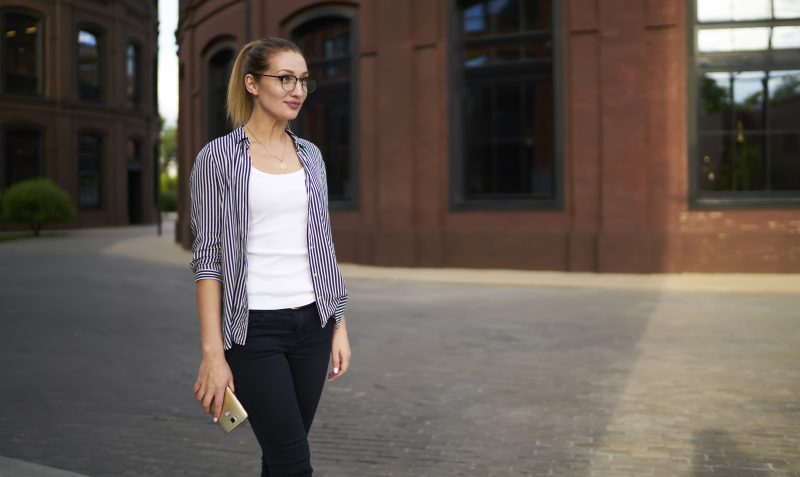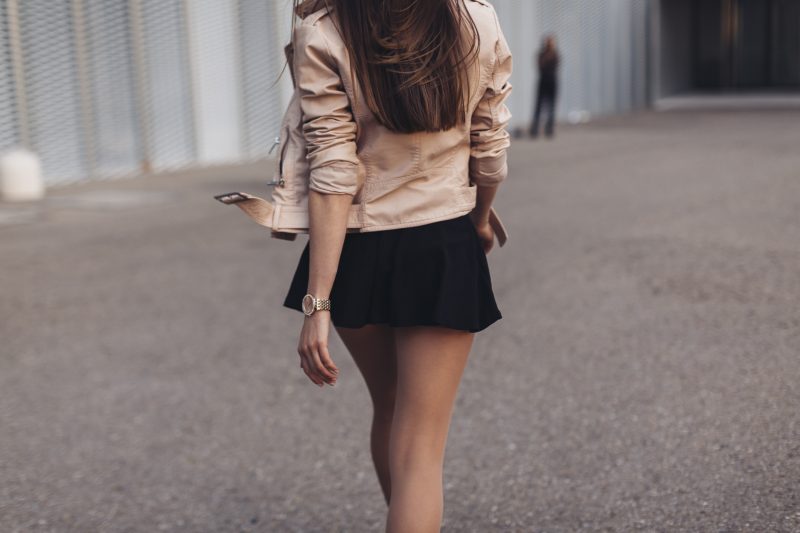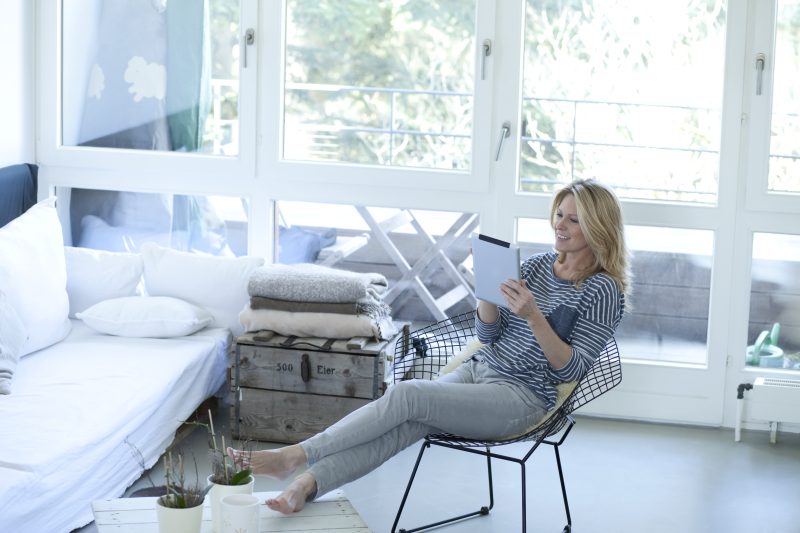It happened again last week. I was at a book launch in Shoreditch, wearing what I considered to be a fairly straightforward outfit – wide-leg jeans, a white shirt, loafers, and a navy blazer. Nothing revolutionary. The sort of thing I throw on when I can’t be bothered to think too hard but need to look presentable. I was chatting with the author when an acquaintance approached, glass of lukewarm white wine in hand, and delivered what she clearly thought was a compliment:
“You always look so put-together! I bet you spent ages planning that outfit.”
I nearly choked on my own lukewarm wine. The outfit had taken approximately three minutes to assemble. The jeans were the only clean pair I had left. The shirt was what I call a “background shirt” – utterly nondescript, does the job of covering my torso without drawing any attention to itself. The blazer was crumpled from being shoved in my tote bag during the day because the weather had turned unexpectedly warm.
But this is the curious paradox at the heart of British style: the highest compliment is to look like you’ve made an effort while simultaneously appearing as though you’ve made none whatsoever. It’s quantum fashion – the outfit must exist in two contradictory states at once. You need to look deliberate but not calculated, considered but not overthought, stylish but not fashion-obsessed.

The Americans have a phrase for it – “effortless chic” – but that doesn’t quite capture the distinctly British neurosis around not wanting to be seen trying too hard. It’s not just about looking effortless; it’s about genuinely convincing others (and perhaps yourself) that you simply rolled out of bed looking this way, that any stylishness is entirely accidental, and that you certainly didn’t stand in front of your wardrobe having an existential crisis for twenty minutes this morning.
I blame our national temperament for this. We’re a country that loves self-deprecation, that squirms at earnestness, that would rather die than be caught taking ourselves too seriously. Admitting you care deeply about your appearance veers dangerously close to the latter, hence the elaborate performance of nonchalance that surrounds British dressing.
My grandmother understood this instinctively. A woman who never left the house without lipstick and proper shoes, she nonetheless maintained the fiction that she “just threw this old thing on” well into her eighties. Once, when complimented on a clearly new blouse, she said with a perfectly straight face, “This? I’ve had it for years. Found it at the back of the wardrobe this morning.” The receipt was literally still in her handbag. I saw it when she took out her handkerchief later.
The art of looking nicely put-together while pretending you haven’t tried requires mastering several contradictory skills simultaneously. You need to develop a personal style that’s distinctive enough to seem intentional but not so distinctive that it looks like you’re trying to stand out. You need to understand quality and fit while pretending you’ve never considered either. You need to be secretly meticulous while appearing utterly carefree.
It’s exhausting, frankly. But after years of observation and practice, I’ve identified the key elements of this peculiarly British approach to dressing.
First, there’s what I call “strategic dishevelment” – the careful introduction of calculated imperfection to avoid looking too polished. This might be a slightly untucked shirt, artfully messy hair, or deliberately mismatched earrings. The key is that these “casual” touches must be in precisely the right places – one undone button is insouciant, two is sloppy. A half-tuck looks effortless; a full tuck with a slightly wrinkled shirt looks like you got dressed in the dark.
My friend Imani has mastered this to an astonishing degree. A management consultant who regularly presents to boards of directors, she always looks immaculate but never too perfect. “I always make sure one thing is slightly off,” she told me once after a few gin and tonics loosened her styling secrets. “If my suit is impeccable, my hair will be a bit messy. If my outfit is very simple, my makeup might be slightly bolder than expected. There has to be tension in the look, otherwise people think you’re trying too hard.”
Then there’s what I think of as “high-low tension” – the deliberate pairing of something expensive or formal with something casual or accessible. Think of an heirloom piece of jewelry worn with a plain white t-shirt, or immaculate tailoring paired with beat-up trainers. Alexa Chung built an entire career on this principle – Chanel bags with Converse, vintage cocktail dresses with biker boots, mannish overcoats with frilly dresses.
The execution is trickier than it looks. Too far in either direction and the whole effect collapses. A designer handbag with a completely scruffy outfit doesn’t look effortless; it looks like you spent your entire clothing budget on the bag. Conversely, an outfit of entirely expensive pieces with one token “casual” item (usually pristine white trainers these days) doesn’t fool anyone – it still reads as trying too hard, just in a different register.
The sweet spot is a genuine mix of cherished investment pieces, high street finds, and true longevity items that have earned their wear naturally. My most consistently complimented outfit combines a men’s cashmere jumper inherited from my grandfather (complete with moth holes that I’ve convinced myself add character), jeans from & Other Stories, and a pair of loafers that I saved up for months to buy. The overall effect suggests I’m a person who understands quality but isn’t precious about it – exactly the impression I’m trying to create, though I’d never admit that’s deliberate.
Another key principle: understand what suits you, then pretend you’ve never given it a moment’s thought. The most elegant British women I know have a clear sense of their best colors, silhouettes, and proportions. They’ve done the work of figuring out that wrap dresses emphasize their waist or that particular shade of blue brings out their eyes. But rather than acknowledging this self-awareness, they’ll say things like, “Oh, I just wear what’s comfortable” or “I don’t really think about fashion much” while coincidentally always wearing what flatters them perfectly.
My colleague Charlotte has worn some version of the same uniform for the decade I’ve known her – a silk blouse, slim cigarette trousers, and ballet flats, with subtle variations in color and detail. She looks unfailingly elegant, completely appropriate for any situation, and gives the impression she simply reached into her wardrobe and happened to pull out the perfect outfit. When I finally called her on this practiced nonchalance after knowing her for years, she laughed and admitted, “I have seventeen versions of the same silk blouse. I know exactly what works. But I’d never let on to people I haven’t known for a decade.”
The British approach to grooming follows similar principles. Good skin is emphasized over obvious makeup, though the “no makeup makeup” that creates that perfect skin often requires more products and technique than a more obvious look. Hair should appear naturally good rather than obviously styled – the highest compliment being “your hair looks great today” rather than “I love what you’ve done with your hair.”
I have a friend who gets a professional blow-dry every week without fail but would sooner die than admit it. “Just washed it this morning,” she’ll say when complimented, as if her perfectly bouncy waves are just how her hair naturally dries. The elaborate fiction must be maintained at all costs.
Accessories play a crucial role in the put-together-but-not-trying matrix. They should be noticeable but not attention-seeking, interesting but not conversation-dominating. The goal is for someone to clock your excellent earrings or perfect bag without feeling that you chose your entire outfit around that piece. Statement jewelry works best when it appears to be an afterthought rather than the centerpiece – “Oh these old things? My grandmother brought them back from India years ago” (conveniently omitting that you had them professionally restored and the posts replaced last month).
Perhaps the most important element is the attitude with which the outfit is worn. You must inhabit your clothes with the air of someone who hasn’t given them a second thought since putting them on. Constant adjusting, checking reflective surfaces, or visibly worrying about how something looks immediately gives the game away. The truly accomplished practitioner of British effortless style appears to have forgotten what they’re wearing entirely – right up until someone compliments a specific element, at which point modest surprise is the only acceptable response.
“This old thing?” is practically a national catchphrase, to be deployed regardless of whether the item in question is genuinely ancient or was purchased specifically for the occasion. I once complimented a friend on a dress at a wedding only to have her respond, “Oh, I’ve had this for ages” when I had literally been with her when she bought it the previous week. The lie was so automatic, so ingrained, that she didn’t even realize she’d said it until I called her out.
The irony, of course, is that achieving this level of “unconsidered” style requires far more thought, planning, and self-awareness than simply trying visibly hard. It’s the sartorial equivalent of those Instagram influencers who spend hours setting up a “candid” shot of themselves laughing naturally over coffee. The effort is invisible but substantial.
My own approach has evolved over time. In my twenties, I experimented constantly, trying on different styles and personalities with each outfit. The results were mixed at best, disastrous at worst. There are photos from that era that make me physically cringe – outfits so clearly constructed for effect, so obviously trying to communicate something about my desired identity rather than my actual self.
Now, in my mid-thirties, I’ve settled into a style that genuinely reflects who I am – a mix of masculine and feminine elements, relatively minimal, with occasional bursts of color or print when the mood strikes. But the real change is that I’ve stopped pretending I don’t care. When someone compliments an outfit, I no longer reflexively downplay it or pretend it was thrown together without thought.

“Thank you,” I’ll say simply. Or sometimes, when speaking to good friends, “I actually spent ages figuring out exactly which white shirt worked with these jeans.” The liberation of occasionally admitting the effort is enormous – a small rebellion against a cultural norm that demands we care intensely while pretending we don’t care at all.
That’s not to say I’ve abandoned all the principles of effortless British style. I still believe in not looking too “done,” in the value of personal pieces over obvious labels, in clothes that look like they belong to your actual life rather than an aspirational version of it. But I’ve shed the layer of pretense that it all happens by accident.
The true masters of looking nicely put-together without appearing to have tried aren’t actually pretending – they’ve internalized their style so thoroughly that it genuinely doesn’t require significant active thought anymore. After years of paying attention, of figuring out what works, of cultivating a personal aesthetic, the process becomes partly subconscious. The outfit assembly happens more intuitively, more automatically, drawing on a deep well of accumulated knowledge rather than active decision-making each morning.
I’m not quite there yet, but I’m getting closer. The jeans-shirt-blazer combination that prompted that comment at the book launch genuinely was thrown together without much consideration, but only because I’ve spent years figuring out exactly which jeans, which shirts, and which blazers work for me in which combinations. The work was done long before that particular morning.
Perhaps that’s the ultimate goal – not to pretend we haven’t tried, but to reach a point where trying becomes so integrated into our understanding of ourselves that it no longer feels like effort.
Where the distinction between effortless and effortful dissolves because we’re simply dressing as ourselves, in clothes that feel right precisely because they reflect who we are with accuracy and honesty.
Until then, I’ll continue observing the curious anthropology of British dressing, the elaborate dance of caring deeply while affecting not to care at all. And occasionally, when asked about an outfit I’ve actually spent considerable time assembling, I might still hear myself saying, “This? Oh, I’ve had it for ages. Just threw it on this morning.”
Some traditions are too deeply ingrained to abandon entirely.



